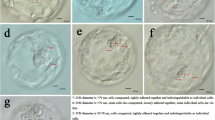Abstract
Background
The development and refinement of blastocyst media in recent years has allowed embryos to be cultured in-vitro for 5 or 6 days post oocyte retrieval and has been established as an effective selection tool to aid embryo selection for IVF treatment. It is generally accepted that blastocyst culture is not an appropriate option for all patients but the criteria for patient selection varies between clinics. Our blastocyst culture programme started in February 2005; the patient criteria was set at a minimum of 4 oocytes retrieved, a minimum of 4 2PN pronuclear embryos and at least 4 8-cell embryos of any quality on Day 3 where the female patient was 34 years and under. In the female age group of 35 years and over the criteria was at least 6 oocytes retrieved, a minimum of 6 2PN pronuclear embryos and at least 6 8-cell embryos of any quality on day 3. Improvements in pregnancy rates demonstrated the effectiveness of blastocyst transfer and clinical opinion was that the criteria should be adjusted to allow this option to be available to an increased patient population. From February 2007 the blastocyst patient selection criteria was changed to at least 4 oocytes retrieved, at least 4 2PN pronuclear embryos and at least 2 8-cell and 2 6-cell or 7-cell embryos of top quality on Day 3 in women 38 years and under. For women 39 years and over the criteria was lowered to at least 5 eggs retrieved, at least 5 2PN and at least 3 8-cell embryos and 2 6-cell embryos of top quality on Day 3.
Methods
Retrospective statistical analysis was carried out to determine the pregnancy rates, live birth rates and twin rate for the period under the initial criteria and to examine the impact that lowering the criteria for patient selection for blastocyst culture had on these parameters.
Results
There was an overall fall in the ongoing pregnancy/live birth rate from 50.9% under the old criteria to 45.0% under the new criteria. However, the patients who had blastocyst culture under the new criteria but would have had day-3 embryo transfer under the initial criteria had a significantly increased live birth/ongoing pregnancy rate from 22.7% to 40.7%. There is an increase in the number of blastocyst culture cycles from 26.4% under the old criteria to 39.1% with the refined criteria. The twin pregnancy rate was reduced from 25.2% to 17.5%.
Conclusion
The result of this cohort study revealed that lowering the blastocyst selection criteria may lead to a lower overall clinical live birth rate from blastocyst culture; however, it will benefit a specific group of patients to achieve a better pregnancy and live birth rate. Furthermore, it increases the number of patients who will benefit from the blastocyst culture programme and also reduces multiple pregnancy rate.
Similar content being viewed by others
References
Munne S. Chromosome Abnormalities and their relationship to morphology and development of human embryos (2006). Reprod Biomed Online. 2006;12(2):234–54.
Beeslet R, Robinson R, Propst A, Arthur N and Retzloff M. Impact of day 3 or day 5 embryo transfer on pregnancy rates and multiple gestations. Fertil Steril May. 2009;(5):1717–20.
Kalu E, Thum MY and Abdalla HI. Reducing multiple pregnancy in assisted reproduction technology: towards a policy of single embryo transfer in younger patients. BJOG 2008;(9):1143–50.
Painikolaou EG, Camus M, Fatemi HM, Tournaye H, Verheyen G, Van Steirteghem A, et al. Early pregnancy loss is significantly higher after day 3 single embryo transfer than after day 5 single blastocyst transfer in GnRH antagonist stimulated IVF cycles. Reprod Biomed Online. 2006;16(1):60–5.
Papinikolaou EG, D’haeseleet E, Verheyen G, Van de Velde H, Camus M, Van Steireghem A, et al. Live birth rate is significantly higher after blastocyst transfer than after cleavage-stage embryo transfer when at least four embryos are available on Day 3 of embryo culture. A ranndomised prospective study. Hum Reprod. 2005;20(11):3198–203.
Santos MJ De los, Mercader A, Galan A, Albert C, Romero JL, Pellicer A. Implantation rates after two, three, or five days of embryo culture. Placenta. 2003;24(Suppl B):S13–9.
Milki AA, Hinckley MD, Fisch JD, Dasig D, Behr B. Comparison of blastocyst transfer with day 3 embryo transfer in similar patient populations. Fertil Steril. 2000;73(1):126–9.
Blake DA, Farquhar CM, Johnson N, Proctor M. Cleavage stage versus blastocyst stage embryo transfer in assisted conception. Cochrane Database syst review. 2007;17(4):CD002118.
Langley MT, Marek DM, Gardner DK, Doody KM, Doody KJ. Extended embryo culture in assisted reproduction treatments. Hum Reprod. 2001;16(5):902–8.
Levitas E, Lunenfeld E, Har-Vardi I, Albotiano S, Sonin Y, Hackman-Ram R, et al. Blastocyst-stage embryo transfer in patients who failed to conceive in three or more 2-3 day embryo transfer cycles: a prospective, randomized study. Fertil Steril. 2004;81(3):567–71.
Boostanfar R, Jain JK, Slater CC, Tourgeman DE, Francis MM, Paulson RJ. The prognostic value of day 3 embryo cleavage sage on subsequent blastocyst development in a sequential culture system. J Assist Reprod Genet. 2001;18(10):548–50.
Rjinders PM, Jansen CA. The predictive value of day 3 embryo morphology regarding blastocyst formation, pregnancy and implantation rate after Day 5 transfer following in-vitro fertilization or intracytoplasmic sperm injection. Hum Reprod. 1998;13(10):2869–73.
Wilson M, Hartke K, Kiehl M, Rodgers J, Brabec C, Lyles R. Transfer of blastocysts and morulae on day 5. Fertil Steril. 2004;82(2):327–33.
Hansotia MD, Desai SK, Zaroliwalla H, Mangoli V, Mongoli R, Koli T. Blastocyst transfer- A way ahead. J Obstet Gynecol India. 2000;50(6):30–3.
Della Ragione T, Verheyen G, Papinikolaou EG, Van Landuyt L, Devroey P, Van Stierteghem A. Developmental stage on Day-5 and fragmentaion rate on Day 3 can influence the implantation potential of top-quality blastocysts in IVF cycles with single embryo trsnfer. Reprod Biol Endocrinol. 2007;5:2.
Author information
Authors and Affiliations
Corresponding author
Additional information
Capsule
Selection criteria for blastocyst culture.
Rights and permissions
About this article
Cite this article
Thum, M., Wells, V. & Abdalla, H. Patient selection criteria for blastocyst culture in IVF/ICSI treatment. J Assist Reprod Genet 27, 555–560 (2010). https://doi.org/10.1007/s10815-010-9457-9
Received:
Accepted:
Published:
Issue Date:
DOI: https://doi.org/10.1007/s10815-010-9457-9



